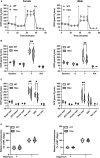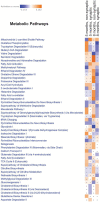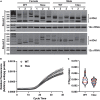Hyperphosphorylated Human Tau Accumulates at the Synapse, Localizing on Synaptic Mitochondrial Outer Membranes and Disrupting Respiration in a Mouse Model of Tauopathy
- PMID: 35359570
- PMCID: PMC8960727
- DOI: 10.3389/fnmol.2022.852368
Hyperphosphorylated Human Tau Accumulates at the Synapse, Localizing on Synaptic Mitochondrial Outer Membranes and Disrupting Respiration in a Mouse Model of Tauopathy
Abstract
Neurogenerative disorders, such as Alzheimer's disease (AD), represent a growing public health challenge in aging societies. Tauopathies, a subset of neurodegenerative disorders that includes AD, are characterized by accumulation of fibrillar and hyperphosphorylated forms of microtubule-associated protein tau with coincident mitochondrial abnormalities and neuronal dysfunction. Although, in vitro, tau impairs axonal transport altering mitochondrial distribution, clear in vivo mechanisms associating tau and mitochondrial dysfunction remain obscure. Herein, we investigated the effects of human tau on brain mitochondria in vivo using transgenic htau mice at ages preceding and coinciding with onset of tauopathy. Subcellular proteomics combined with bioenergetic assessment revealed pathologic forms of tau preferentially associate with synaptic over non-synaptic mitochondria coinciding with changes in bioenergetics, reminiscent of an aged synaptic mitochondrial phenotype in wild-type mice. While mitochondrial content was unaltered, mitochondrial maximal respiration was impaired in synaptosomes from htau mice. Further, mitochondria-associated tau was determined to be outer membrane-associated using the trypsin protection assay and carbonate extraction. These findings reveal non-mutant human tau accumulation at the synapse has deleterious effects on mitochondria, which likely contributes to synaptic dysfunction observed in the context of tauopathy.
Keywords: Alzheimer’s disease; aging; bioenergetics; phosphorylation; proteomics; synaptic mitochondria; tau; tauopathy.
Copyright © 2022 Trease, George, Roland, Lichter, Emanuel, Totusek, Fox and Stauch.
Conflict of interest statement
The authors declare that the research was conducted in the absence of any commercial or financial relationships that could be construed as a potential conflict of interest.
Figures









Similar articles
-
Broad activation of the PRKN pathway triggers synaptic failure by disrupting synaptic mitochondrial supply in early tauopathy.Autophagy. 2022 Jun;18(6):1472-1474. doi: 10.1080/15548627.2022.2039987. Epub 2022 Feb 19. Autophagy. 2022. PMID: 35188059 Free PMC article.
-
Early depletion of CA1 neurons and late neurodegeneration in a mouse tauopathy model.Brain Res. 2017 Jun 15;1665:22-35. doi: 10.1016/j.brainres.2017.04.002. Epub 2017 Apr 11. Brain Res. 2017. PMID: 28411086
-
GSK3β-mediated tau hyperphosphorylation triggers diabetic retinal neurodegeneration by disrupting synaptic and mitochondrial functions.Mol Neurodegener. 2018 Nov 22;13(1):62. doi: 10.1186/s13024-018-0295-z. Mol Neurodegener. 2018. PMID: 30466464 Free PMC article.
-
Synaptic Mitochondria: An Early Target of Amyloid-β and Tau in Alzheimer's Disease.J Alzheimers Dis. 2021;84(4):1391-1414. doi: 10.3233/JAD-215139. J Alzheimers Dis. 2021. PMID: 34719499 Review.
-
Disruption of neuronal function by soluble hyperphosphorylated tau in a Drosophila model of tauopathy.Biochem Soc Trans. 2010 Apr;38(2):564-70. doi: 10.1042/BST0380564. Biochem Soc Trans. 2010. PMID: 20298222 Review.
Cited by
-
Temporal Appearance of Enhanced Innate Anxiety in Alzheimer Model Mice.Biomedicines. 2023 Jan 18;11(2):262. doi: 10.3390/biomedicines11020262. Biomedicines. 2023. PMID: 36830799 Free PMC article.
-
Site-specific phosphorylation of tau impacts mitochondrial biology and response to stressors.bioRxiv [Preprint]. 2023 Feb 19:2023.02.19.529131. doi: 10.1101/2023.02.19.529131. bioRxiv. 2023. Update in: J Neurochem. 2024 Jun;168(6):1019-1029. doi: 10.1111/jnc.15975. PMID: 36824940 Free PMC article. Updated. Preprint.
-
Mitochondrial DNA Instability Supersedes Parkin Mutations in Driving Mitochondrial Proteomic Alterations and Functional Deficits in Polg Mutator Mice.Int J Mol Sci. 2024 Jun 11;25(12):6441. doi: 10.3390/ijms25126441. Int J Mol Sci. 2024. PMID: 38928146 Free PMC article.
-
High-molecular-weight oligomer tau (HMWoTau) species are dramatically increased in Braak-stage dependent manner in the frontal lobe of human brains, demonstrated by a novel oligomer Tau ELISA with a mouse monoclonal antibody (APNmAb005).FASEB J. 2024 Nov 30;38(22):e70160. doi: 10.1096/fj.202401704R. FASEB J. 2024. PMID: 39565643 Free PMC article.
-
Mitochondrial dysfunction in Alzheimer's disease: Guiding the path to targeted therapies.Neurotherapeutics. 2025 Apr;22(3):e00525. doi: 10.1016/j.neurot.2025.e00525. Epub 2025 Jan 17. Neurotherapeutics. 2025. PMID: 39827052 Free PMC article. Review.
References
Grants and funding
LinkOut - more resources
Full Text Sources
Molecular Biology Databases

